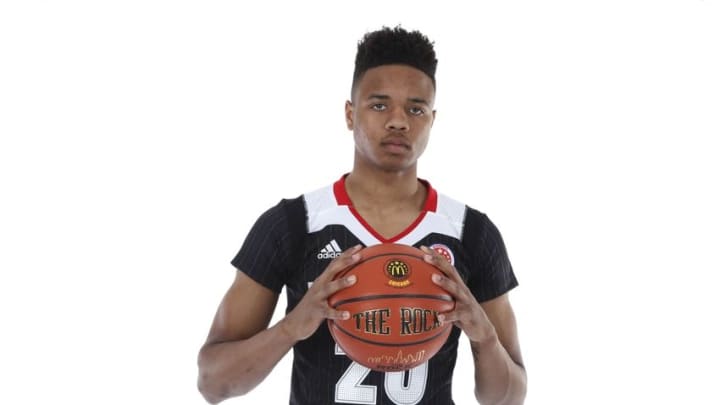The 2017 NBA draft class has one glaring question mark

The NBA has put an absolute premium on outside shooting in recent years. With the emergence of Steph Curry and the success of teams like the Golden State Warriors, San Antonio Spurs, and Cleveland Cavaliers, nearly every team is considering spacing and perimeter threats first and foremost in their offensive team-building structure.
This past year in the NBA Draft, we saw Buddy Hield threaten to go in the top 5, Taurean Prince land in the lottery, and Malachi Richardson go in the 1st round, primarily because of their ability to knock down outside shots. Three-point shooting has become so integral to NBA offenses that even ground-and-pound posts like Enes Kanter have experimented with adding an outside shot. It stands to wit, then, that the 2017 NBA Draft would again see outside shooting as a major factor in who is drafted — and when.
The 2017 NBA Draft class should be loaded from an athleticism standpoint. The class is built around 8-12 freshmen who could all be impact guys right away at the college level. In the Draft Express 2017 mock, three point guards headline the class, as Washington’s Markelle Fultz, N.C. State’s Dennis Smith, and top international prospect Frank Ntilikina all are in the mix for top-5 billing early on. Jayson Tatum of Duke and Josh Jackson of Kansas give the class a pair of absurdly athletic wings, and the top 10 is rounded out by Duke’s Harry Giles and Marques Bolden, Kentucky’s Bam Adebayo, and Texas’s Jarrett Allen in the post. It’s a group that’s heavy on athleticism and defensive potential across the board.
More from FanSided
- Patriots backup plan for DeAndre Hopkins is a shot in the dark
- Raiders: Saquon Barkley’s new contract may have screwed over Josh Jacobs
- Clark Hunt throws cold water on potential Chiefs throwbacks
- Packers: 3 free agency mistakes Brian Gutekunst should already regret
- Cowboys give a masterclass in defense construction with Trevon Diggs extension
However, there is one flaw that could manifest itself as we look ahead to next June. While this class has everything you could ask for in terms of potential and physical tools, the shooting ability of these players leaves a lot to be desired. There isn’t a Brandon Ingram or Jamal Murray among the elite in this class as a guy who oozes potential to be a knockdown shooter. Particularly among the top wings in the class, shooting could be a significant issue.
Tatum and Jackson are probably the two players that this applies to the most, as neither has shown the ability to translate decent shooting touch from midrange into a consistent perimeter jumper. Tatum is an excellent midrange weapon, where he has decent touch and a solid handle to create separation. But at the Nike Hoops Summit, he didn’t take a single three, and he doesn’t seem comfortable in catch-and-shoot situations at this point. Jackson meanwhile has the handle to be a pull-up shooter, but he’s yet to fully harness it. His motion isn’t very fluid, and he can struggle to get rotation on the ball. He’s been working heavily on this over the summer as he heads to Lawrence, but it remains to be seen if either wing can take that major step forward to a more lofty NBA projection.
The guards are a little bit more polished, although that’s not the highest of praise. Three-point shooting is Ntilikina’s biggest weakness at this point, as he’s just a 31 percent shooter thus far in his career. He’s improved his mechanics in the last year or so, and did shoot 84.6 percent from the line at the FIBA U18 Euro championships in 2015. However, the 6’5″ point needs to show he can continue growth in this area as he makes a competitive leap to a rotation spot at Strasbourg. Fultz and Smith are more polished shooters, but even they have their warts: Smith has shot 28.5 percent from three this summer, per Draft Express, and while Fultz has looked good in camps, he shot just 33.3 percent from three at the FIBA U18 American championships. Fultz likely has the most promise of the three, as he’s developed significantly in the last year and takes primarily catch-and-shoot jumpers.
Of the bigs, Bolden is the most likely to develop into any sort of perimeter threat, proving to be a confident midrange shooter, and he should be able to flesh that skill out more confidently at Duke. Allen takes these shots but doesn’t consistently hit them, and Giles isn’t much of a threat to shoot beyond 10 feet to this point.
There are reinforcements for this class, of course. There are sure to be several upperclassmen who emerge as perimeter threats in the NCAA this year, and guys like Tyler Lydon of Syracuse and Grayson Allen of Duke have great chances to propel themselves up the draft board with big years. Finnish big Lauri Markkanen should be the premiere stretch forward candidate this year, and players like Malik Monk of Kentucky and Jonathan Isaac of Florida State could easily make a big impression early on with their shot-making abilities.
Shooting is also one of the easiest skills to improve in the transition from high school to the NCAAs. The added spacing and more cohesive ball movement of college offenses will make a difference for some players, and it’s safe to assume that some of the players with consistency issues, like Jackson and Smith, will iron those out to an extent.
But as things stand right now, shooting is a topic to focus on when evaluating many of the top 15 prospects headed into the 2016-17 college basketball season, and several of them will need to overcome a history of poor shooting to eventually make a big splash on the NBA level.